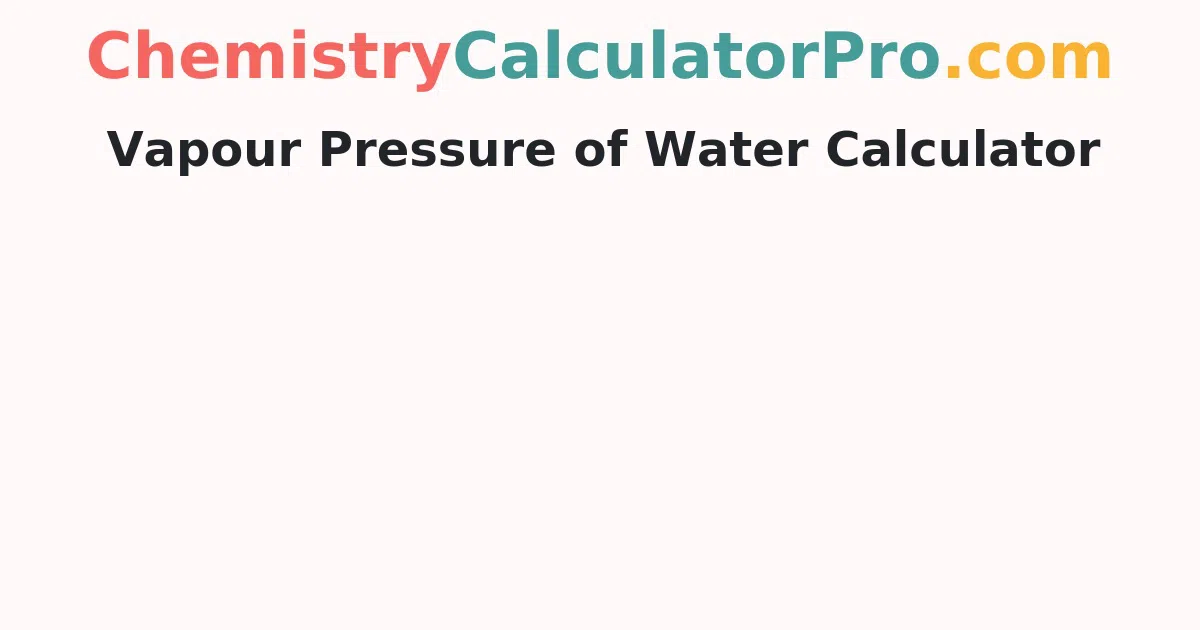Vapour Pressure of Water Calculator
The Vapour Pressure of Water Calculator is an online tool that evaluates the vapour pressure of a liquid or solid in real-time. To quickly get the result, simply type in all of the essential information in the calculator's input boxes and press the calculate button.
What Does Water Vapour Pressure Mean?
The pressure at which the gas phase and the liquid phase are in balance is known as the vapour pressure of water. When the surface tension of water is high, it indicates that the vapour pressure of the water is low. The vapour pressure in a closed container is constant. The vapour pressure of a material varies depending on the type of the substance and the ambient temperature.
It simply means that when the temperature is high enough, the molecules have enough energy to escape from solid or liquid materials, resulting in high vapour pressure. In the same way, a substance with a low force should have a high vapour pressure.
Clausius-Clapeyron Equation
If the vapour pressure and enthalpy of vaporisation are known, the Clausius-Clapeyron equation can be used to estimate the vapour pressure at any other temperature. When the temperature rises, the vapour pressure is also rising. dP/dT = H / (T * ΔV) is the Clapeyron equation.
- Where, dP/dT = derivative of pressure with respect to temperature
- H = specific latent heat (the thermal energy absorbed or released during a phase transition)
- T = temperature.
- ΔV = change of the specific volume
The relationship between vapour pressure and liquid temperature is described by the Clausius-Clapeyron equation. Vaporization is the phase transition between a liquid and a gas, while sublimation is the phase transition between a solid and a gas. When the specific volume of the molecular gas phase and the condensed phase differs significantly, we apply the formula below.
ln(P₁/P₂) = ΔH/R * (1/T₂ - 1/T₁)
- Where,
- T₁ = initial temperature
- P₁ = initial pressure
- T₂ = final temperature
- P₂ = final pressureΔH is the molarity enthalpy of vaporization
- R = universal gas constant = 8.3145 J/mol*K
- The enthalpy of vaporisation is the amount of energy required to turn a liquid into a gas.
Using Raoult's Law to Calculate Vapour Pressure
The solvent vapour pressure in a solution is equal to the vapour pressure of the pure solvent times the mole fraction of the solution, according to Raoult's law. Psolution = Psolvent x Xsolvent
- Where, Psolution = The vapour pressure of the solution.
- Psolvent = The vapour pressure of the pure solvent.
- Xsolvent = The mole fraction of the solvent.
How to Use the Water Vapour Pressure Calculator?
The following is the procedure how to use the water vapour pressure calculator
- Step 1: In the input field, input the temperature (for example, 49°C).
- Step 2: To acquire the vapour pressure, click the "Solve" button.
- Step 3: Finally, the output field will show the vapour pressure of water at the given temperature (for example, the vapour pressure of water at 49°C = 87.81748 mm Hg).
FAQ’s on Vapour Pressure of Water Calculator
1. What does the term vapour pressure mean?
Vapour pressure, which rises with temperature, is used to quantify a substance's tendency to change to a gaseous or vapour form. The temperature at which the vapour pressure at a liquid's surface equals the pressure exerted by its surroundings is known as the boiling point.
2. What is a liquid's vapour pressure?
The vapour pressure of a liquid is the pressure at which molecules leaving the liquid and entering the gaseous phase, as well as molecules leaving the gaseous phase and entering the liquid phase, attain equilibrium in a closed container.
3. In kPa, what is the vapour pressure of water?
Water is a polar liquid with moderately strong hydrogen bonding that attracts its molecules together. At 20°C, water has a vapour pressure of 2.33 kPa, which is significantly less than diethyl ether.
4. How does vapour pressure differ from atmospheric pressure?
The following are some ofq the most essential aspects of vapour pressure
- In comparison to the liquid's solution, a pure liquid has a ahigher vapour pressure.
- As the temperature rises, so does the vapour pressure increase.
- It's inversely proportional to the attraction forces between a liquid's existing molecules.
